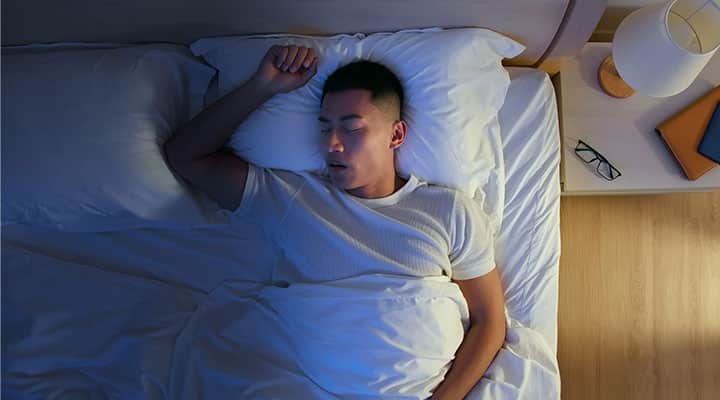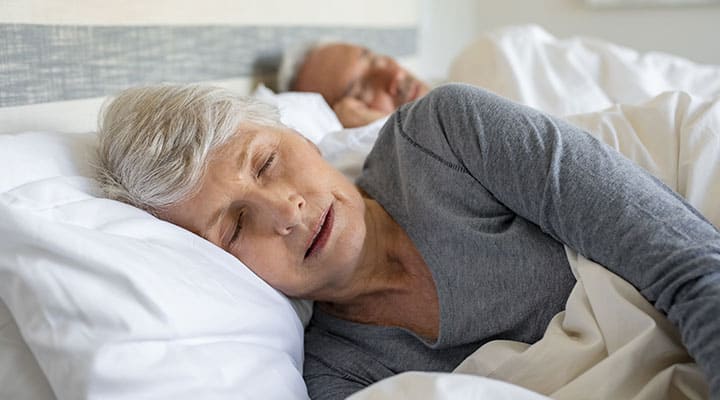
How To Get More REM Sleep
Published: July 2021
Have you ever gone to sleep and woke up refreshed and ready to face the day? Great! Now, how about the opposite: have you ever gone to sleep, only to roll out of bed tired, ready for nothing more than to simply roll over and try again? We’ve all been there.
As it turns out, there’s a reason that not all sleep sessions are created equal: your body needs to get REM sleep in order to really recharge your batteries. Sleep in general is good for your mental health and cognition—REM sleep most of all. So what is REM sleep, and how do you get more of it?
Tuck yourself in—we’re about to find out.
What is REM sleep?

REM stands for “rapid eye movement,” and it’s the phase of sleep when we dream. It’s also called “paradoxical sleep,” because your body’s motor functions, brain activity and yes, eye movements, are very similar to what they are when you’re awake. (Think about all of that blinking you do in a typical day!) Your heart rate is higher during REM sleep than the rest of the night—perhaps it’s those exciting (or scary) dreams.
The exact function of REM sleep is still a mystery, albeit a well-studied one. What we do know: REM sleep is essential to the cognitive processes of learning and memory, and is thought to be when your brain collates data and turns short term memories into long term ones. That’s why not getting enough REM can have a long-term impact on your brain health.
But you were in bed all night—how could you have not experienced enough REM? You don’t get to the rapid eye movement phase until you’re in the fourth stage of sleep, in a 4-stage sleep cycle that repeats itself several times during a typical 8 hours of sleeping.
Here’s how that cycle works, and how it’s possible to skip the stage we all need the most.
The 4 stages of sleep

Every night, your body attempts to repeat the following 4 steps, multiple times:
- Stage 1 – light sleep. Also called N1, this stage of non-REM or NREM sleep only lasts about 1-5 minutes. Your body hasn’t fully relaxed, and there’s only slight changes in brain activity. It’s easy to wake up during this stage… but if you don’t, your body and mind quickly move on to stage 2.
Fun fact: Don’t be a (hypnic) jerk
Have you ever felt like you were falling right before you fell asleep? That’s called a hypnic or hypnogogic jerk—and relax, its nothing to worry about.
It’s very common and while there’s no set theory for what causes this phenomenon, it’s generally agreed that what you’re experiencing is your body muscles relaxing at once in preparation for sleep, but your brain isn’t all the way unconscious yet. The muscles relax, your mind freaks out, and you jolt awake.
If this happens often, try limiting caffeine in the hours before bed and relaxing a little bit: stress has been linked to hypnic jerks.
Stage 2 – N2 sleep. This phase lasts for 10-25 minutes, and can get longer as your sleep cycle repeats itself during the night. So much so that you’ll spend about half your total sleep cycle in N2 sleep every night.
So what happens during N2? You begin to really relax: your body temperature drops, your muscles relax, breathing and heart rate slows down and eye movement stops. Your brain waves have a new pattern during N2 as well—one that actually helps it resist being woken up by external noises or stimuli.
Stage 3 – N3 or deep sleep. This is where your brain starts creating delta waves. Sleep scientists are sure this stage is critical for healthy sleep, because it’s when your body recharges itself. Your muscles, pulse and breathing will be at their most relaxed during deep sleep. Deep sleep is also important to your immune health.
During any given sleep cycle, you’ll be in deep sleep for 20-40 minutes. It’s important to know that as you sleep, N3 stages get shorter—you get the most “deep sleep” in the first half of the night. After that, REM sleep reigns supreme.
Stage 4 – REM sleep. This is the final phase in the cycle, and it’s when you dream. Your brain activity actually increases, nearing the same levels as when you’re awake. But the different parts of your brain aren’t as coordinated as they would be during the day. Some scientists speculate that this is why dreams sometimes have a chaotic nature to them.
REM sleep lasts about 90 minutes per cycle, and if you should experience it a few times every night. (This is one reason why you need between 7 and 9 hours of uninterrupted sleep as an adult: the less sleep you have, the fewer sleep cycles you complete.)
REM sleep cycles are longer in the latter half of your night. So the shorter your shuteye, the less quality REM sleep you’re going to get. This is why skimping on sleep is never a good idea.
Explore Our Best Sleep Supplements
Why is REM sleep important?

REM sleep is thought to be when your brain collates data and turns short term memories into long term ones. One interesting theory is that REM sleep is when your brain “sorts” the important memories from the insignificant ones—keeping stuff like where you left your car keys or how to ride a bike and tossing the “noise” like a beeping microwave, your neighbor's dog barking or the color of a passing car.
Whatever your mind is doing during REM sleep, it's important—brain energy measured by blood sugar and oxygen metabolism indicates that your mind uses as much or more resources during REM sleep as when you're awake.
What causes a lack of REM sleep?

REM sleep is part of a normal sleep cycle. Your sleep cycles are tied to your circadian rhythms, which are our internal biological “clocks” that maintain our body's 24-cycles: things like sleep-wake cycles as well as already-healthy blood pressure, cholesterol and heart rate levels. So, if you disrupt your circadian rhythms, you'll likely experience poor-quality sleep without enough REM.
The most common causes of disrupted circadian rhythms—and by association, REM sleep—come from the outside world around you: too much light (especially the artificial kind) or traveling to a different time zone (we commonly call this “jet lag”).
How can I support REM sleep?

Follow these tips to support the quality and quantity of your REM sleep:
- Aim for a solid 8 hours. We know that sleep happens in a cycle. Therefore, to improve your REM sleep (read: getting more REM sleep every night) you need to get the maximum number of sleep cycles as possible. Since each sleep cycle can last from 90 minutes to 2 hours, you'll need at least 7.5 hours of sleep a night. Let's round up to 8.
- Be an early bird. No matter how many hours you get, the earlier you start, the better. This is because your REM sleep is concentrated towards the end of your sleep cycle. So if you're still trying to log REM hours when the rest of the world wakes up, that's not going to help matters.
- Check the thermostat. The temperature around you—either too hot or too cold—has an effect on REM sleep. Specifically, it can prevent you from entering REM sleep at all… even if it doesn't wake you up. Since REM sleep is temperature sensitive, your best bet is to find a sleeping temperature that is just right! Consider whether your bedding is too heavy or too thin—and while you're at it, make sure your mattress isn't part of the problem, too.
- Play soothing tunes. Anyone with children knows lullabies are a thing. And it turns out adults can benefit too: playing music before you fall asleep can improve sleep quality. Interestingly enough, it can also improve sleep efficiency: how fast you fall asleep. And the more quickly you fall asleep (phase 1) the more easy it will be for you to achieve that much-needed phase 4 of REM.
Are there foods that increase REM sleep?

The line between foods that help you sleep and foods that help REM sleep is not clear. But there are some obvious no-no's: caffeine, sugary sweets and low-quality diets all negatively affect sleep patterns. Skip the booze, too.
When it comes to carbohydrates and protein, go for low to modest levels of carbs and medium to higher levels of lean protein—avoid saturated and trans-fat as much as possible (for a host of good reasons). If you must eat something sweet after dinner, choose kiwis: this small, green fruit has strong antioxidant properties as well as high concentrations of serotonin.
You can also try tart cherries, either as the whole fruit, the juice or even as a nutritional supplement extract. Tart cherries help with exercise recovery, and also contain high concentrations of melatonin.
Is there a supplement for REM sleep?
Speaking of melatonin: this naturally occurring hormone supports healthy circadian rhythms, and is widely available in supplement form. And no wonder: there are very, very few nutrients that are as well known and clinically studied for sleep health. But not everyone wants to or can take melatonin. Ashwagandha with black cumin seed extract is a great way to calm those restless thoughts so you can ease into the sleep of your dreams.
You know that urban legend about turkey making you sleepy? Turns out there might be some truth to it. Tryptophan is an amino acid found in turkey that promotes mood health, healthy stress response as well as optimal sleep patterns.
Sweet dreams
So now you know all about REM sleep—where dreams live and where your body sorts your memories. It's important to remember that like the rest of your health, sleep is made up of many important parts. So relax and get some rest…you deserve it!
References
- Cherry, Kendra. “The Impact of Delta Waves on Deep Sleep.” Verywellmind, November 2019, https://www.verywellmind.com/what-are-delta-waves-2795104
- Holland, Kimberly. “Twitching Before Falling Asleep: What Causes Hypnic Jerks?” Healthline, November 2019, https://www.healthline.com/health/hypnagogic-jerk
- Rehman, Anis, Dr. “Music and Sleep.” Sleep Foundation, June 2021, https://www.sleepfoundation.org/noise-and-sleep/music
- Singh, Abhinav, Dr. “Why Do We Need Sleep?” Sleep Foundation, September 2020, https://www.sleepfoundation.org/how-sleep-works/why-do-we-need-sleep
- St-Onge, Marie Pierre. “Effects of Diet on Sleep Quality.” Adv Nutr., September 2016, https://pubmed.ncbi.nlm.nih.gov/27633109/
- “How Much Sleep Do I Need?” Centers for Disease Control and Prevention, March 2017, https://www.cdc.gov/sleep/about_sleep/how_much_sleep.html
Like what you read?
Please subscribe to get email updates on this blog.





